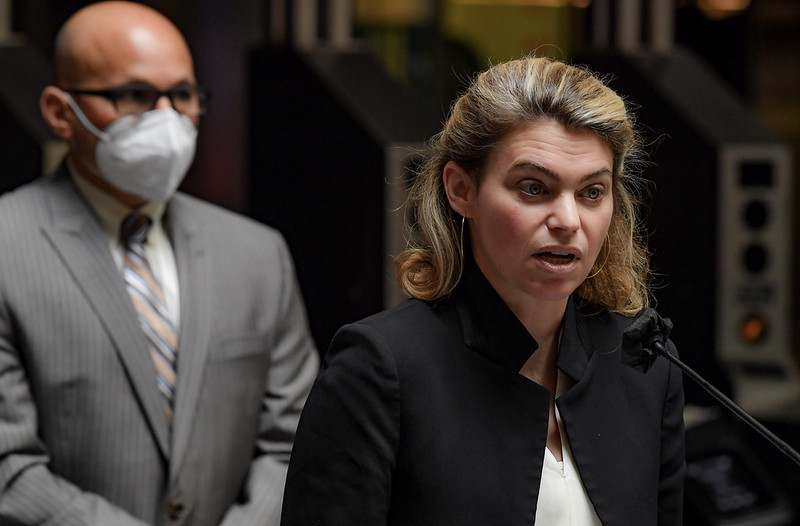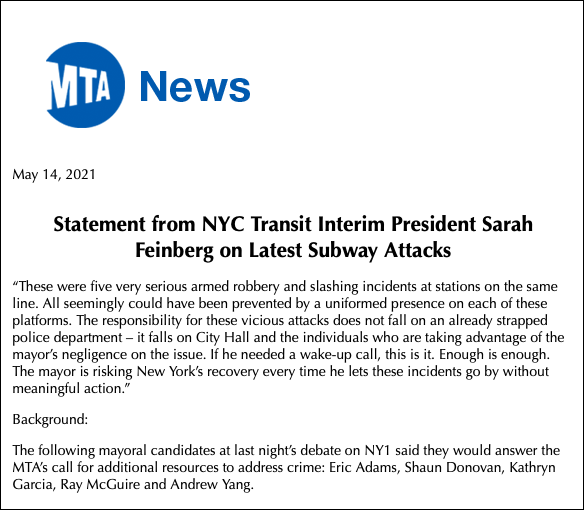NYC Transit: Here’s Your Ranked Choice Mayoral Ballot For Candidates Who Will Flood The Subways With Cops


Political ads are banned in the subway, but they’re apparently kosher for an MTA press release.
On Friday morning, New York City Transit Interim President Sarah Feinberg again blamed Mayor de Blasio for a string of overnight subway assaults that occurred on the 4/5/6 line — but the agency’s statement also included implied support for five mayoral candidates who agree with the MTA’s demand for more police underground.
“The responsibility for these vicious attacks does not fall on an already strapped police department – it falls on City Hall and the individuals who are taking advantage of the mayor’s negligence on the issue,” Feinberg said. “If he needed a wake-up call, this is it. Enough is enough. The mayor is risking New York’s recovery every time he lets these incidents go by without meaningful action.”
The release then added: “Background: The following mayoral candidates at last night’s debate on NY1 said they would answer the MTA’s call for additional resources to address crime: Eric Adams, Shaun Donovan, Kathryn Garcia, Ray McGuire and Andrew Yang.” (If you’re counting along at home, that list left off Dianne Morales, Maya Wiley and Scott Stringer.)
It is common for elected officials to both govern and make political endorsements, but Feinberg is supposed to be a nonpartisan executive carrying out the people’s work. The transit agency doesn’t lobby this hard when its own state funding is threatened.
“For a non-elected state public servant to be attempting to influence candidates for city office is simply inappropriate,” said Rachael Fauss, a senior research analyst who studies the MTA for the good government group Reinvent Albany. “There’s no doubt that there are problems but politicizing the issue and acting as a cat’s paw for the Governor is not how the MTA can best help the riding public.”
Feinberg’s statement comes after several weeks when the transit agency (and the man who controls it, Gov. Andrew Cuomo), has been insisting that the subway is not safe for riders who are returning to the system as the pandemic wanes, and demanded that the NYPD flood the system with more cops.
Painting an accurate picture of crime in the subway system is confusing because the MTA and the NYPD argue over two sets of statistics. According to the most recent data from the police department, whose 2,500 officers do most of the policing in the subways, all crime in the transit system is down by 43 percent compared to this point last year. Major felonies are also down this year. Last week, the city agreed to send “auxiliary” police into the system to conduct patrols.
Citing that data, city officials have accused the state of “fearmongering” — while also saying they are addressing the substance of the MTA’s concerns.
“The city has pulled cops off desk duty and put them on platforms and trains. We’re going to keep putting massive resources into this fight to keep our subways safe,” mayoral spokesman Bill Neidhardt told Streetsblog, criticizing the press release. “Meanwhile the MTA sends out statements that point fingers and talk about mayoral politics. Get with the program, help us fight back this crime.”
MTA jumped the shark with an overtly political statement.
Their response to stabbings is to endorse a shortlist of mayoral candidates?
Taking political swipes at the mayor without a mention of a 500 officer surge on top of a 2,500-strong transit force.
Politics before facts. https://t.co/UJ84qHwwsi
— Bill "worst comms guy in history" Neidhardt (@BNeidhardt) May 14, 2021
The MTA insists that crime is too high given its current low ridership, and points to incidents of assaults against riders and staff. Officials also say that ridership surveys show that fear of crime is a major factor in preventing people from returning to the system. On Tuesday, the subway served 2,142,152 riders, which is 62 percent fewer than a comparable pre-pandemic period.
Feinberg’s list of approved candidates dovetails with Gov. Cuomo’s recent outburst about the lack of safety in the subway.
“Don’t lie to me and don’t play me as a fool. I’m on the subway. It’s safe. Oh, really? Have you been on the subway? Because I have. And I was scared,” Cuomo said last week. “Tell your child to ride subway, it’s safe. I’m not telling my child to ride the subway, because I’m afraid for my child.”
Asked about Feinberg’s statement, Cuomo spokesman Rich Azzopardi said, “Talk to the MTA.”
We did. MTA spokesman Tim Minton told Streetsblog that the press office included the “background” material “to assist reporters in their contextual approach to the story.”
He then relitigated the issue … at length.
“So, the reality is that tens of thousands of New Yorkers and tens of thousands of MTA employees have been saying exactly what was in the release — that enough is enough and there are too many victims with too little a visible uniformed police presence in the subways that would clearly act as a deterrent to the kind of attacks that occurred again today. This comes at a time when a record number of New Yorkers is returning to the transit system, both subways and buses. Their safety and belief that they are safe are essential to the return not only of transit but of New York City.”
Streetsblog reminded Minton that it is extremely rare — if it has happened at all — that official press releases from the state agency promote campaign positions of specific candidates.
“That’s a fair point,” Minton said. “But I’ll say one more thing: The MTA is not making endorsements. Period. We are looking out for the safety of riders and our employees.”
The MTA also referred to a tweet from agency Communications Director Abbey Collins disputing most observers’ reading of the situation:
This is absolutely false. All the background is pointing out is something we’ve been saying for weeks – that the city needs to meet the issue head on, that it should be discussed and debated, & the mayor seems is the only person at this point who doesn’t see a serious problem https://t.co/lZMkbpidcC
— Abbey Collins (@abbey_e_collins) May 14, 2021
Behind this latest salvo in the ongoing war of words between Cuomo and de Blasio is whether those five candidates who apparently support the MTA’s call for more cops would succeed in reducing crime or merely inflating the police budget with security theater.
Lauren Liles, a spokesperson for Dianne Morales, suggested that more cops is not the answer.
“We’ve increased police over and over in the subways and it’s not stopping anything, but it is prompting the MTA to politicize violence,” she said. “We can’t decouple the recent violence that has taken place from the increased housing insecurity, increased food insecurity, increased lack of access to health care services. We need solutions at the root here, solutions that are bigger than police.”
Neither Wiley nor Stringer immediately responded to our request for comment.
In the end, advocates were left shaking their heads at Feinberg’s less-than-subtle political endorsement.
“It’s the worst of Cuomo’s MTA,” Danny Pearlstein, the policy and communications director for the Riders Alliance, said about the statement. “He is weaponizing the MTA for his political purposes in punching down at the mayor. … The result is that actual people are scared on the transit system because Cuomo is demagoguing the issue.”
Pearlstein said that the best way to improve safety on the subway is to get more people riding it, which they will be more hesitant to do if the governor of New York goes on television saying it’s dangerous.
“If the result is fewer people in the transit system, and they are less safe as a result, then it is directly his fault.”
— with Gersh Kuntzman
Update: Story was updated with new information and a deeper explanation from the MTA at 2:45 p.m. Friday.